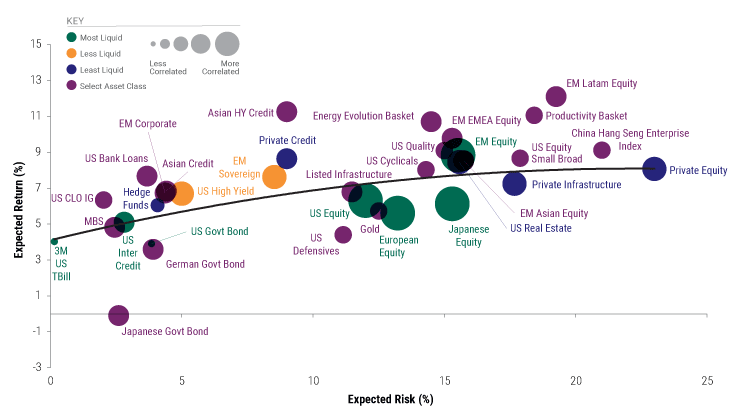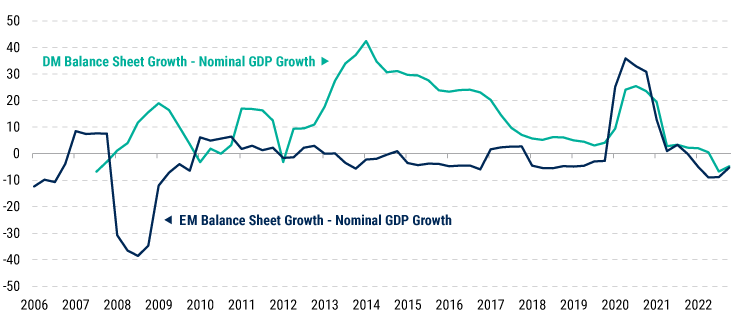2023 Midyear Multi-Asset Outlook: Shifting Shores

Michael J. Kelly, CFA
Global Head of Multi-Asset
China’s recovery is merely pausing and looks poised to reaccelerate, driven by policymakers’ “new pragmatism” – stepping up deregulatory and monetary stimulus even as developed markets lean the other way. By year-end we expect China to be viewed as the “least-dirty shirt” of the major global economies, with its gravitational pull supporting investment in Asia and other emerging markets.
Within global equities, we remain defensive on broader developed market stocks given current overvaluations. We maintain a more favorable outlook on select emerging market equities – Indian equities are secularly poised to accelerate amid rising foreign direct investment. Productivity and climate-related investments are our highest-conviction themes and appear capable of powering through a general slowdown.
In global fixed income, Asia high yield looks most compelling, but the risk/reward for longer investment grade (IG) developed market bonds is also attractive. In a softish recession, higher-quality credits should remain fundamentally unscathed, and intermediate to longer-duration US investment grade credit looks interesting. Asia high yield presents a compelling medium-term opportunity to earn high carry with very low duration with distinct diversifying properties to core DM portfolios.
In alternatives, we expect high dispersion among “green commodities,” with aluminum and cobalt looking quite attractive, while lithium appears unattractive, largely due to supply dynamics. Meanwhile, new vintages in mid-market private credit look poised to benefit from pullbacks in regional bank lending.

Over the course of 2023, our investment mantra has been “Go East” – and at midyear, this stance appears more relevant than ever. With fundamentals in Asia and emerging markets pausing, and markets questioning China’s ongoing recovery and policy pivots, we see a medium-term opportunity opening once again to shift allocations from West to East.
This is borne out in our Capital Market Line, where Asian and other EM asset classes are attractively valued relative to most core markets – a dynamic that hasn’t occurred for some time, based on our framework.
Asian and EM Asset Classes Look Compelling
Capital Market Line – local currency

As of 31 May 2023. Based on PineBridge Investments’ estimates of forward-looking five-year returns and standard deviation. The Capital Market Line (CML) is not intended to represent the return prospects of any PineBridge products, only the attractiveness of asset class indices, compared across the capital markets. Note that the CML’s shape and positioning were determined based on the larger categories and do not reflect the subset categories of select asset classes, which are shown relative to other asset classes only.
Key Convictions
1. China’s recovery is merely pausing and looks poised to reaccelerate, driven by policymakers’ new pragmatism – providing tailwinds to Asia and other emerging markets.
China’s faster-than-expected first-quarter growth sparked excitement before giving back ground, but we believe the nation’s recovery has legs. Policymakers have been attempting a service-based recovery with restrained stimulus from the outset, in contrast with the generous fiscal and monetary policies accompanying reopening elsewhere or China’s fiscally led infrastructure thrusts of the past.
While most think in terms of two policy levers (monetary and fiscal), all countries have a third: the regulatory lever. China had used fiscal as its primary lever prior to President Xi’s ascent. Monetary policy remained tight, unlike many other countries’ policies for most of the last 20 years – perhaps due to China’s concerns about what happened in Japan, which had allowed a property bubble to infiltrate and break its banking system in the late 1980s, leading to two lost decades. During President Xi’s reign, China has used the regulatory lever more forcefully, in contrast with most other countries – it’s now the “go-to.”
That regulatory lever was pulled into restraint mode many times since; at first with supply-side cuts of dirty industrial plants, next with shadow bank reform, and then, starting in 2021, with technology, education, gaming, and property sector reforms – not to mention “zero-Covid.” Then in November 2022, China reversed course and began easing instead of tightening the regulatory levers (on the property and tech segments, among others) that, along with zero-Covid (also dismantled), had slowed the domestic economy quite dramatically in 2021 and 2022. These were China’s two slowest years, while the rest of the world was overheating. This pivot to “Common Prosperity” was too severe for the economy, and since November we’ve witnessed a “new pragmatism” that balances Common Prosperity with the need for a strong economy. We expect this trend to continue.
China’s depressed economy in 2021 and 2022 did stop property prices from rising, but it also seriously damaged private sector confidence. Now property owners are questioning whether their home prices will fall, and whether to sell. No property bubbles in that dynamic; the time for tight money in China is behind us. With inflation running very low, a good case can be made for easing. Along with a more aggressive deregulatory lever, we see an interesting stimulus mix while most other countries have run out of fiscal space and are maintaining restrictive monetary policies, by holding policy rates high well into 2024 while continuing to shrink their central balance sheets.
While global investors rightly question the risks to China’s market and economy around what many are dubbing a new Cold War, this same risk is also steering China toward its new pragmatism. The Soviet Union lost its Cold War because its economy couldn’t keep up. China’s policymakers understand this.
GDP estimates for China, at 5.5% for 2023, remain well above those of most other countries, with the exception of India (another of our favorites). As GDP boomed in the first quarter, the validity of this growth came into question without earnings meaningfully turning up in sync. This owed in large part to services (which are underrepresented in China’s stock market), and services led the first-quarter boom. Services purchasing managers’ indices (PMIs) in China are holding at very high levels, and over time this strength will create employment opportunities; this, along with regulatory relief, will begin to chip away at the decline in private sector confidence. Our prior caution on China for much of the last five years was on the expectation that private sector confidence would decline. It certainly did, yet we now expect it to begin rising again before year-end as the private sector gradually sees that the new pragmatism is not a flash in the pan.
With China stepping up deregulatory and monetary stimulus, and developed markets continuing to withdraw liquidity until growth slips, by year-end we expect China to be viewed as the “least-dirty shirt” of the major global economies. Its gravitational pull should also support investment in Asia and other emerging markets. Should the US achieve a softish recession, global goods production – which had already been running well below retail takeaway since last Christmas – must at some point spring back. That would disproportionately benefit Asia (China in particular, which has not priced this in, whereas Japan has). We see an upcoming medium-term decoupling of EM/DM fundamentals, in favor of EM. Meanwhile, DM markets are still rallying right to the edge of the slowdown and/or recession, leading us to “Go East” within the context of a broadly cautious stance.
Beyond growth fundamentals, the chart below highlights the relative paths of excess liquidity (proxied by central bank balance sheet growth relative to nominal GDP growth). Some of DM markets’ outperformance over the last decade was “performance enhancing,” with DM central banks growing their balance sheets massively faster than their nominal GDP, while EMs kept on the straight and narrow. That extra tailwind for DM is ending and is actually poised to undershoot through 2024. This prior differential has been an underappreciated driver of relative performance.
EM and DM Central Bank Balance Sheet Growth vs. Nominal GDP Growth

Source: Macrobond as of 31 December 2022.
2. Within global equities, proceed with caution – but a decoupling between EM and DM fundamentals makes emerging markets more attractive.
We remain defensive on broader developed market stocks, particularly given current overvaluations teamed with looming credit tightening, growing risk aversion by banks, along with a steady fiscal impulse to date in the US (which needs to reverse) and ongoing declines in the Fed and ECB balance sheets, even after rate hikes pause. When growth slows (or is poised to decline) in one area, we focus on those where it can accelerate – particularly secular winners that can grow earnings more resiliently amid persistent tailwinds. Productivity (the antidote to a global shortage of workers) and climate-related investments (with a $2.9 trillion annual funding gap to meet net-zero targets according to our estimates, leading to acceleration of related firms’ income statements) are our highest-conviction themes and appear capable of powering through a general slowdown.
We maintain a more favorable outlook on select emerging market equities. We foresee these markets benefiting from increasing cash flows without resultant monetary restraint, which (if right) should reverse the extreme caution priced into China. This stands in contrast to likely reductions in both cash flows and liquidity in the US and Europe, with pricing that looks overconfident and appears to be pricing in an upturn off an immaculate landing. We also like Indian equities, which are secularly poised to accelerate amid rising foreign direct investment (FDI), which has slowly warmed to Prime Minister Modi’s policies. India also benefits from a growing labor force and a refortified banking system that, along with FDI, is nurturing a nascent credit and investment cycle.
3. Asia fixed income looks most compelling, but the risk/reward for DM bonds is also attractive.
The outcome of our Capital Market Line (CML) process indicates structurally higher inflation and yields compared to the last cycle (albeit lower than at present), stemming from tighter labor markets and the splitting of global supply chains as companies address rising geopolitical tensions. However, yields now offer a positive real yield, and as inflation belatedly fades, a more attractive risk/reward profile for developed market bonds will emerge.
The Fed’s focus is on settling policy rates into a slightly higher band, with a much longer holding period. We believe the extended hold makes the economy vulnerable to growth shortfalls. Quantitative tightening will be the last restrictive lever to go. After a long fight over raising the debt ceiling, the Treasury must now rebuild its general account, which should drain liquidity as well. These two forces are creating a final bout of upward pressure on rates, which we don’t expect to last much longer. This sets up a nine- to 18-month opportunity to extend duration one last time. In a softish recession, higher-quality credits should fare well, and intermediate to longer-duration US investment grade credit looks interesting.
Asia high yield (HY) currently presents a compelling and longer-lasting opportunity to earn high carry with very low duration. Compared to US high yield, Asia HY offers less breadth but with higher spreads, supported by improving credit fundamentals. This makes Asia HY a diversifying alternative for fixed income investors seeking spread-narrowing opportunities that complement core DM portfolios, where the upcoming soft patch/recession offers more yield curve relief than any potential spread widening, at least when sticking with higher-quality credits.
4. Alternatives are mixed, with tailwinds for new private credit commitments and a hazy forecast for commodities.
Commodities are caught in conflicting cross-currents, making their trajectory uncertain. China’s services-led recovery is domestically focused, without the traditional commodity tailwinds seen when its stimulus is fiscally driven. Meanwhile, most DM economies have been experiencing a goods recession for some time now. Economic slowing from here would likely need to come from the services side. When goods production finally rebounds back up to retail takeaway, this will be particularly beneficial to commodities (and Asian economies, as producers and exporters of goods). Here, patience is required.
Within “green commodities,” we foresee a high dispersion of returns. Aluminum and cobalt look quite attractive, while lithium appears unattractive. A significant divergence in supply growth is behind this divide, with less-appealing markets suffering from a glut of supply coming onstream due to prior investments.
Meanwhile, new vintages in mid-market private credit look poised to benefit from pullbacks in regional bank lending. Fresh capital can now step into a wider addressable opportunity for mid-market companies, with much improved spreads and terms. We see opportunity for equity-like returns in this space within fixed income.
For more of our views on what investors and markets can expect in the second half, visit our 2023 Midyear Investment Outlook.
Disclosure
Investing involves risk, including possible loss of principal. The information presented herein is for illustrative purposes only and should not be considered reflective of any particular security, strategy, or investment product. It represents a general assessment of the markets at a specific time and is not a guarantee of future performance results or market movement. This material does not constitute investment, financial, legal, tax, or other advice; investment research or a product of any research department; an offer to sell, or the solicitation of an offer to purchase any security or interest in a fund; or a recommendation for any investment product or strategy. PineBridge Investments is not soliciting or recommending any action based on information in this document. Any opinions, projections, or forward-looking statements expressed herein are solely those of the author, may differ from the views or opinions expressed by other areas of PineBridge Investments, and are only for general informational purposes as of the date indicated. Views may be based on third-party data that has not been independently verified. PineBridge Investments does not approve of or endorse any republication of this material. You are solely responsible for deciding whether any investment product or strategy is appropriate for you based upon your investment goals, financial situation and tolerance for risk.



